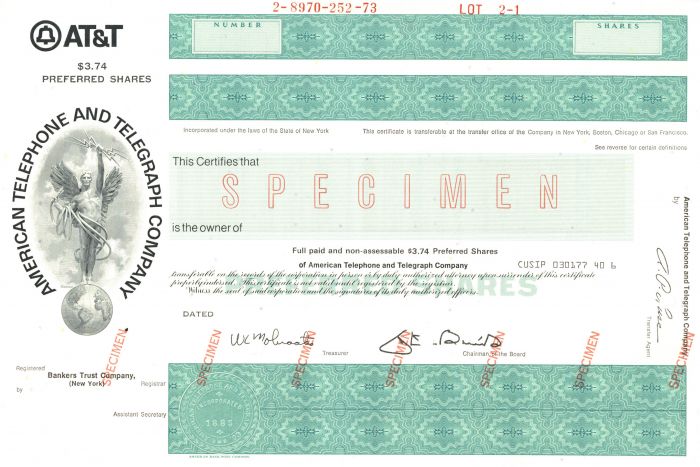American Telephone and Telegraph Co. - AT&T Specimen Stock Certificate
Inv# SE1379 Specimen Stock
Specimen Stock printed by American Bank Note Company. AT&T was established as the Bell Telephone Company by Alexander Graham Bell, Thomas Watson, and Gardiner Greene Hubbard following Bell's patent of the telephone in 1875. By 1881, the company had evolved into the American Bell Telephone Company. Among its subsidiaries was the American Telephone and Telegraph Company (AT&T), which was founded in 1885. On December 30, 1899, AT&T acquired the assets of its parent company, American Bell Telephone, thereby becoming the new parent entity. AT&T developed a network of local telephone subsidiaries across the United States. Throughout the majority of the twentieth century, AT&T and its subsidiaries maintained a monopoly on telephone services, which was sanctioned by government authorities in 1913 through the Kingsbury Commitment. This monopoly was referred to as the Bell System, and during this era, AT&T was colloquially known as Ma Bell. In 1982, U.S. regulators dismantled the AT&T monopoly, mandating the company to divest its local subsidiaries, which were reorganized into seven distinct entities. These newly formed companies became known as Regional Bell Operating Companies, or informally, Baby Bells. While AT&T continued to provide long-distance services, it encountered growing competition from rivals such as MCI and Sprint.
Southwestern Bell Corporation (SBC) emerged as one of the entities formed following the dissolution of AT&T Corp. The company quickly embarked on a series of acquisitions, notably including the purchase of Metromedia's mobile division in 1987 and several cable companies during the early 1990s. In the latter part of the 1990s, SBC expanded its portfolio by acquiring additional telecommunications firms, which included two Baby Bells: Pacific Telesis Group and Ameritech Corporation, while divesting its cable operations. During this period, the organization rebranded itself as SBC Communications Inc. In early 1997, C. Michael Armstrong was appointed as CEO, and he subsequently designated John Zeglis as president later that same year. By 1998, SBC ranked among the top 15 companies in the Fortune 500, and by 1999, when Zeglis took on the roles of chairman and CEO of AT&T Wireless, AT&T had become a component of the Dow Jones Industrial Average, a status it maintained until 2015. Zeglis concluded his tenure as president of AT&T in 2001 and stepped down from his roles at AT&T Wireless in 2004.
Stock and Bond Specimens are made and usually retained by a printer as a record of the contract with a client, generally with manuscript contract notes such as the quantity printed. Specimens are sometimes produced for use by the printing company's sales team as examples of the firms products. These are usually marked "Specimen" and have no serial numbers.










Ebay ID: labarre_galleries